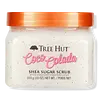What's inside
What's inside
 Key Ingredients
Key Ingredients

 Benefits
Benefits

 Concerns
Concerns

 Ingredients Side-by-side
Ingredients Side-by-side

Sucrose
HumectantGlycerin
HumectantPolysorbate 20
EmulsifyingSilica
AbrasiveCocos Nucifera Oil
MaskingAnanas Sativus Fruit Extract
Skin ConditioningPrunus Amygdalus Dulcis Oil
Skin ConditioningMacadamia Ternifolia Seed Oil
EmollientOenothera Biennis Oil
EmollientCitrus Aurantium Dulcis Oil
MaskingButyrospermum Parkii Butter
Skin ConditioningPersea Gratissima Oil
Skin ConditioningCarthamus Tinctorius Seed Oil
MaskingCocos Nucifera Shell Powder
AbrasiveAscorbic Acid
AntioxidantRetinyl Palmitate
Skin ConditioningWater
Skin ConditioningParfum
MaskingSorbic Acid
PreservativePhenoxyethanol
PreservativeCaprylyl Glycol
EmollientLimonene
PerfumingCI 77891
Cosmetic ColorantSucrose, Glycerin, Polysorbate 20, Silica, Cocos Nucifera Oil, Ananas Sativus Fruit Extract, Prunus Amygdalus Dulcis Oil, Macadamia Ternifolia Seed Oil, Oenothera Biennis Oil, Citrus Aurantium Dulcis Oil, Butyrospermum Parkii Butter, Persea Gratissima Oil, Carthamus Tinctorius Seed Oil, Cocos Nucifera Shell Powder, Ascorbic Acid, Retinyl Palmitate, Water, Parfum, Sorbic Acid, Phenoxyethanol, Caprylyl Glycol, Limonene, CI 77891
Water
Skin ConditioningSodium Hydroxypropyl Starch Phosphate
AbrasiveLauric Acid
CleansingSodium Lauroyl Isethionate
CleansingSodium Methyl Lauroyl Taurate
CleansingCocamidopropyl Betaine
CleansingHydrogenated Soybean Oil
EmollientGlycine Soja Oil
EmollientSodium Chloride
MaskingGlycerin
HumectantParfum
MaskingStearic Acid
CleansingPalmitic Acid
EmollientHydrogenated Vegetable Glycerides
EmollientHydroxystearic Acid
CleansingGlyceryl Stearate
EmollientTheobroma Cacao Seed Butter
EmollientCocos Nucifera Oil
MaskingHydrogenated Vegetable Oil
EmollientSodium Benzoate
MaskingGuar Hydroxypropyltrimonium Chloride
Skin ConditioningCapryloyl Glycine
CleansingUndecylenoyl Glycine
CleansingCitric Acid
BufferingSodium Gluconate
Skin ConditioningCoumarin
PerfumingHexyl Cinnamal
PerfumingLinalool
PerfumingCI 42090
Cosmetic ColorantCI 17200
Cosmetic ColorantCI 19140
Cosmetic ColorantWater, Sodium Hydroxypropyl Starch Phosphate, Lauric Acid, Sodium Lauroyl Isethionate, Sodium Methyl Lauroyl Taurate, Cocamidopropyl Betaine, Hydrogenated Soybean Oil, Glycine Soja Oil, Sodium Chloride, Glycerin, Parfum, Stearic Acid, Palmitic Acid, Hydrogenated Vegetable Glycerides, Hydroxystearic Acid, Glyceryl Stearate, Theobroma Cacao Seed Butter, Cocos Nucifera Oil, Hydrogenated Vegetable Oil, Sodium Benzoate, Guar Hydroxypropyltrimonium Chloride, Capryloyl Glycine, Undecylenoyl Glycine, Citric Acid, Sodium Gluconate, Coumarin, Hexyl Cinnamal, Linalool, CI 42090, CI 17200, CI 19140
 Reviews
Reviews

Ingredients Explained
These ingredients are found in both products.
Ingredients higher up in an ingredient list are typically present in a larger amount.
Cocos Nucifera Oil is obtained from the kernels of the coconut fruit. In other words, this is coconut oil.
Coconut Oil is rich in fatty acids with lauric acid making up the majority of these. It also contains linoleic acid. Due to this high fatty acid content, coconut oil helps trap moisture and soften skin.
Despite being antibacterial, coconut oil may not be great for acne-prone skin. It is comedogenic and may clog pores. This ingredient may not be safe for malassezia or fungal acne.
Note: Coconut Oil should not replace your sunscreen for UV protection. Studies show it only blocks about 20% of UV.
This oil is non-volatile and has a light scent.
The term 'fragrance' is not regulated in many countries. In many cases, it is up to the brand to define this term. For instance, many brands choose to label themselves as "fragrance-free" because they are not using synthetic fragrances. However, their products may still contain ingredients such as essential oils that are considered a fragrance.
Learn more about Cocos Nucifera OilGlycerin is already naturally found in your skin. It helps moisturize and protect your skin.
A study from 2016 found glycerin to be more effective as a humectant than AHAs and hyaluronic acid.
As a humectant, it helps the skin stay hydrated by pulling moisture to your skin. The low molecular weight of glycerin allows it to pull moisture into the deeper layers of your skin.
Hydrated skin improves your skin barrier; Your skin barrier helps protect against irritants and bacteria.
Glycerin has also been found to have antimicrobial and antiviral properties. Due to these properties, glycerin is often used in wound and burn treatments.
In cosmetics, glycerin is usually derived from plants such as soybean or palm. However, it can also be sourced from animals, such as tallow or animal fat.
This ingredient is organic, colorless, odorless, and non-toxic.
Glycerin is the name for this ingredient in American English. British English uses Glycerol/Glycerine.
Learn more about GlycerinParfum is a catch-all term for an ingredient or more that is used to give a scent to products.
Also called "fragrance", this ingredient can be a blend of hundreds of chemicals or plant oils. This means every product with "fragrance" or "parfum" in the ingredients list is a different mixture.
For instance, Habanolide is a proprietary trade name for a specific aroma chemical. When used as a fragrance ingredient in cosmetics, most aroma chemicals fall under the broad labeling category of “FRAGRANCE” or “PARFUM” according to EU and US regulations.
The term 'parfum' or 'fragrance' is not regulated in many countries. In many cases, it is up to the brand to define this term.
For instance, many brands choose to label themselves as "fragrance-free" because they are not using synthetic fragrances. However, their products may still contain ingredients such as essential oils that are considered a fragrance by INCI standards.
One example is Calendula flower extract. Calendula is an essential oil that still imparts a scent or 'fragrance'.
Depending on the blend, the ingredients in the mixture can cause allergies and sensitivities on the skin. Some ingredients that are known EU allergens include linalool and citronellol.
Parfum can also be used to mask or cover an unpleasant scent.
The bottom line is: not all fragrances/parfum/ingredients are created equally. If you are worried about fragrances, we recommend taking a closer look at an ingredient. And of course, we always recommend speaking with a professional.
Learn more about ParfumWater. It's the most common cosmetic ingredient of all. You'll usually see it at the top of ingredient lists, meaning that it makes up the largest part of the product.
So why is it so popular? Water most often acts as a solvent - this means that it helps dissolve other ingredients into the formulation.
You'll also recognize water as that liquid we all need to stay alive. If you see this, drink a glass of water. Stay hydrated!
Learn more about Water